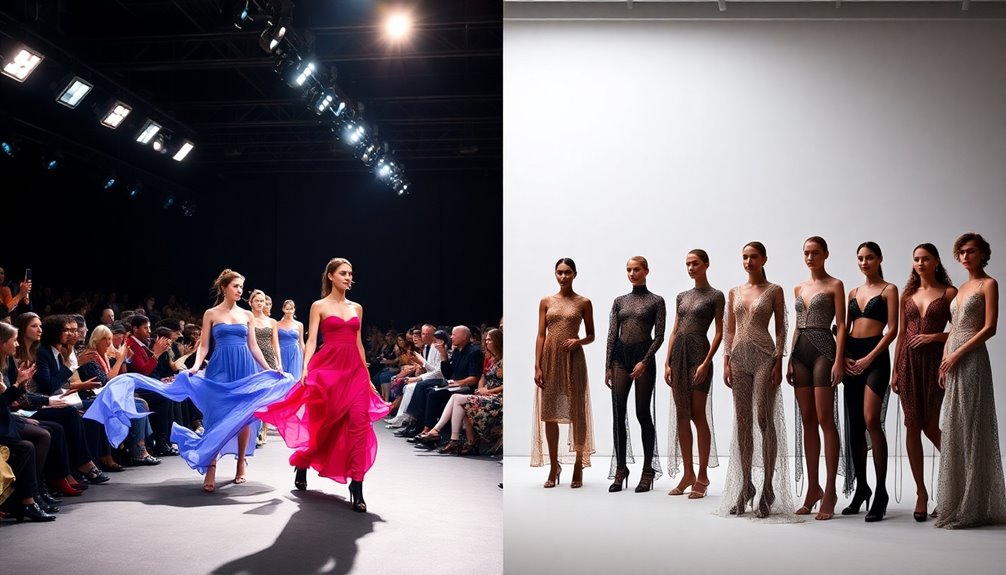When choosing a fashion side hustle for supplementary income, look for flexibility that fits your schedule and lifestyle. Assess your skills in design or marketing, as these can boost your success. Consider the initial investment versus potential earnings; startups can be low-cost but must align with your financial goals. Identify your target market to tailor your offerings. Stay engaged with trends and maintain strong client relationships. Lastly, plan for growth as you build a customer base. With the right approach, your fashion passion can turn profitable and fulfilling, opening the door to exciting opportunities ahead.
Key Takeaways
- Assess your skills and creativity to find a fashion side hustle that aligns with your strengths and interests.
- Evaluate startup costs and ensure they fit within your budget for manageable investment.
- Consider market demand and target demographics to tailor your offerings effectively.
- Develop a flexible schedule to balance your side hustle with existing commitments without becoming overwhelmed.
- Utilize social media and online platforms for marketing to reach a broader customer base.
Flexibility and Time Commitment

Balancing a side hustle in fashion with your regular commitments can be a game-changer, especially when it comes to flexibility in scheduling. You get to set your own hours, allowing you to align your fashion projects with your day job and personal life. This freedom lets you choose which clients and projects excite you the most, giving you a sense of control over your creative journey.
However, effective time management is crucial. You need to create a schedule that dedicates time to your side hustle without overwhelming yourself. Consistency is key; small, regular efforts can lead to significant outcomes over time, so plan accordingly. Additionally, many individuals find that engaging in a fashion side hustle can enhance their skillsets and provide valuable learning opportunities.
Adaptability also plays a vital role. You can easily pivot to meet different client needs or explore various fashion niches based on market demand. This flexibility helps you adjust your workload according to your personal commitments, making it easier to maintain a healthy work-life balance.
Ultimately, designing a side hustle in fashion allows you to pursue your passion while juggling other responsibilities, enhancing both your professional growth and personal satisfaction.
Required Skills and Expertise

In the world of fashion side hustles, having the right skills and expertise can set you apart from the competition. First and foremost, creativity is key. You'll need to innovate new patterns, styles, and shapes while mastering art skills like sketching and fashion illustration to effectively bring your designs to life. Understanding design aesthetics, including fashion trends and color theory, will help your work resonate with potential customers.
On the technical side, proficiency in design software such as Adobe Illustrator and CAD tools is essential. Being comfortable with sewing, fabric knowledge, and basic graphic design will enhance your capabilities. Additionally, having a strong understanding of different fabric types will enable you to select the best materials for your designs.
Don't overlook the importance of business and organizational skills; budgeting, marketing strategies, and strong organizational abilities can keep your hustle running smoothly.
Interpersonal skills are equally vital. You must communicate effectively with clients and team members, negotiate with suppliers, and manage client relationships.
Leadership and copywriting skills will help you guide your team and create engaging marketing content. By honing these skills, you'll be better positioned to thrive in the dynamic world of fashion side hustles.
Initial Investment Considerations

Starting a fashion side hustle often requires careful thought about your initial investments. The costs can vary significantly, with average startup expenses ranging from $50 to $550,000. If you're focusing on a niche, expect to invest between $49 and $70,000, though median costs hover around $3.5K.
To make the most of your investment, consider essential expenditures. Investing in education and training can equip you with vital skills. Coaching or mentorship can provide personalized feedback and help accelerate your business growth. Furthermore, ongoing education can keep you updated on the latest trends and techniques in the fashion industry.
You'll also need minimal equipment, like a clothing rack and hangers, as well as basic tools—think computer, phone, and internet connection.
Don't overlook marketing. Creating a website or social media accounts is crucial, and you might want to budget for ads or collaborations with influencers to boost visibility. If you aim for a more upscale presentation, professional website design and quality camera equipment could be necessary.
Start small and avoid unnecessary expenses like fancy office furniture in the beginning. As your business grows and begins generating income, you can gradually increase your financial investment.
Potential Earnings Overview
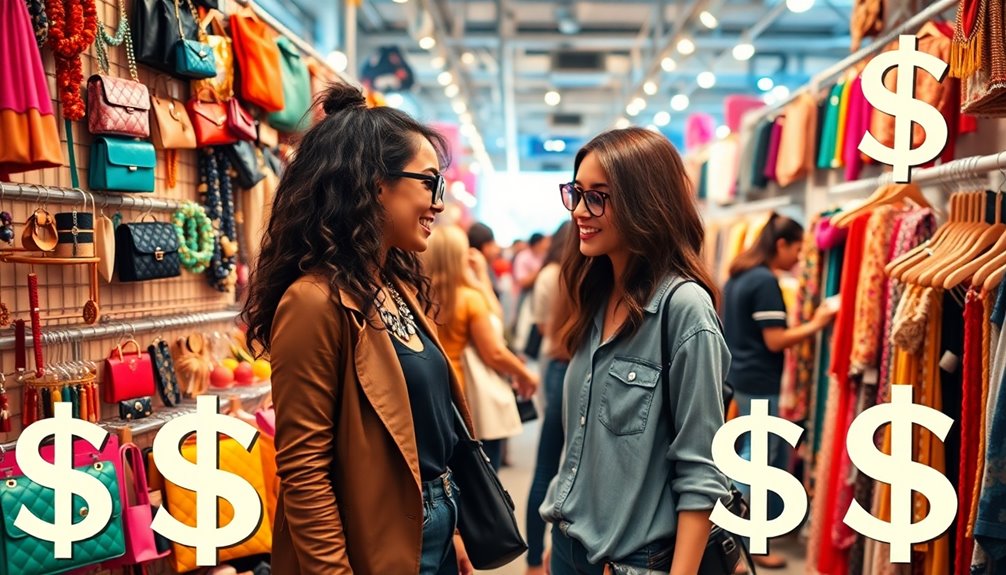
As you consider the initial investments for your fashion side hustle, it's equally important to understand the potential earnings that can come from your efforts. Freelance opportunities in fashion writing or design can be lucrative, especially if you possess specialized skills like patternmaking. Personal styling and image consulting can also provide significant income, with client fees varying based on the services you offer. If you're into alterations, partnering with local boutiques can lead to a steady income stream. Additionally, engaging in networking events can further enhance your visibility and client acquisition. Utilizing online marketplaces can greatly expand your reach, allowing you to tap into broader customer bases. Creating unique merchandise or fashion illustrations can generate additional earnings through platforms like Redbubble or Etsy, especially when you focus on high-quality products. Virtual assistance in fashion is another avenue where competitive pay rates are available, driven by high demand. On the product side, selling custom or upcycled clothing can yield profits, especially when marketed online or at local markets. Teaching fashion courses or workshops can also provide a solid income, whether conducted online or in person.
As you grow your client base and diversify your income streams, your earning potential increases. Ultimately, transitioning your side hustle into full-time entrepreneurship can lead to even greater financial rewards.
Understanding Market and Client Base
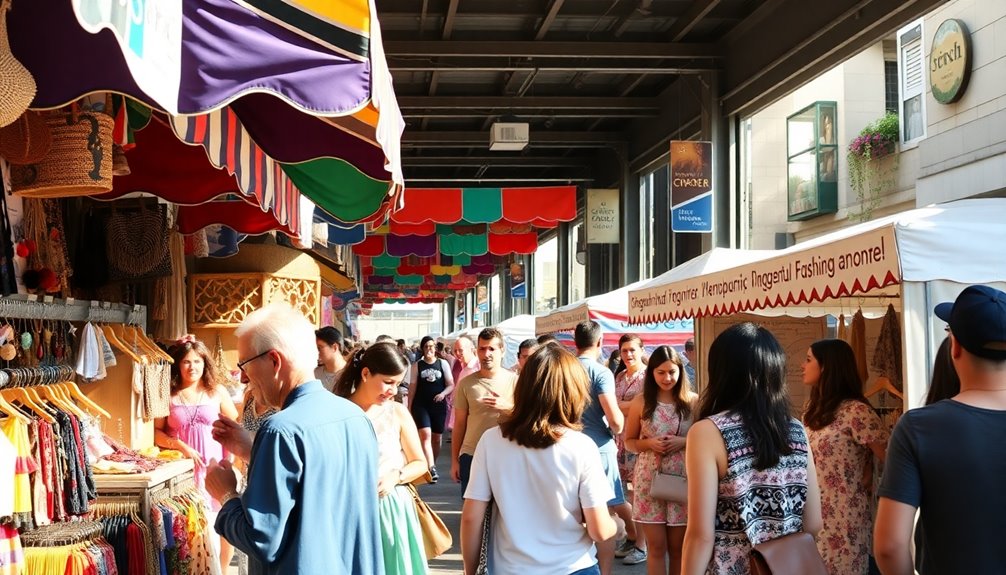
Understanding your market and client base is crucial for the success of your fashion side hustle. Start by identifying your target market demographics, including age, gender, location, education level, and income. This information helps you tailor your products and marketing strategies to meet the specific preferences and purchasing behaviors of your audience.
Next, dive into the psychographics of your target market. Explore their interests, values, lifestyles, and personality traits. Knowing what resonates with them allows you to create a brand that feels authentic and connects on a deeper level. Pay attention to their buying behavior and online habits, as these insights will guide your marketing tactics. In 2023, 44% of new small businesses originated as side hustles, highlighting the growing interest in this market segment.
Engaging with your client base is equally important. Leverage social media channels like Instagram to showcase your work and interact with potential customers. Attend fashion events to network and build relationships, and consider collaborations with established brands to increase your visibility.
Lastly, don't underestimate the power of feedback. Conduct surveys to understand your clients' needs and pain points, ensuring your offerings remain relevant and appealing. With this knowledge, you're better equipped to thrive in the competitive fashion industry.
Opportunities for Growth and Scalability
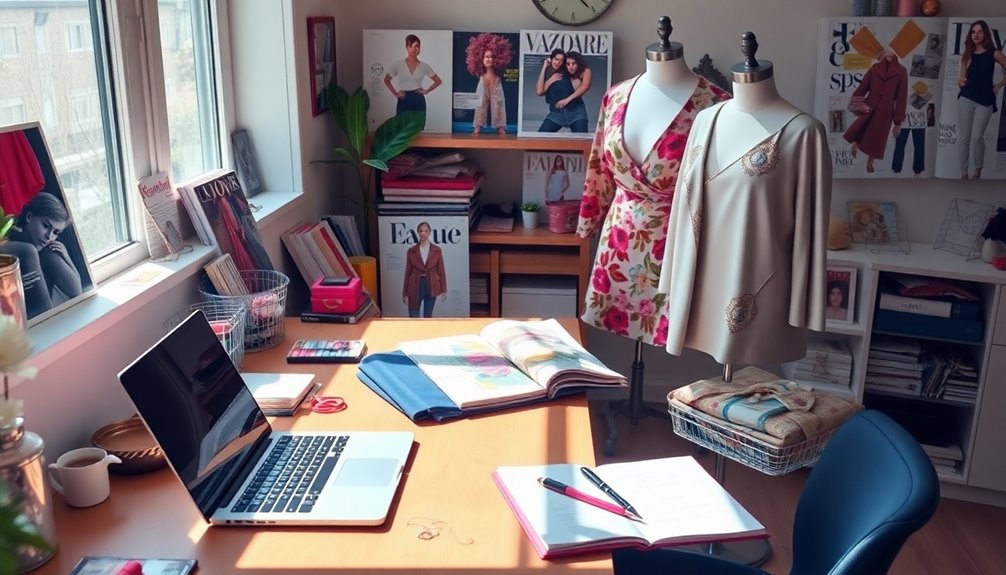
Numerous opportunities exist for growth and scalability in your fashion side hustle, especially in areas like garment decoration. With low barriers to entry such as heat-transfer and Direct-to-Film (DTF) methods, you can start without a hefty investment or extensive space. This flexibility makes it easier to balance your hustle with a full-time job.
Consider defining your business model clearly—what you'll offer and who your target market is. Set realistic goals that are specific and measurable, ensuring you track your progress effectively. Financial projections will help you understand your startup costs and potential revenue, guiding your decisions. Engaging with potential customers through surveys and interviews can provide valuable insights into their preferences and needs.
As you establish a stable customer base, think about expanding your product lines or adding complementary services. Streamlining operations through automation can significantly enhance efficiency, allowing you to handle increased demand.
Leverage technology to integrate your e-commerce and supplier catalogs, broadening your reach. To maximize growth, consider diversifying your revenue streams, like renting out samples or offering pattern creation services.
Popular Fashion Side Hustles
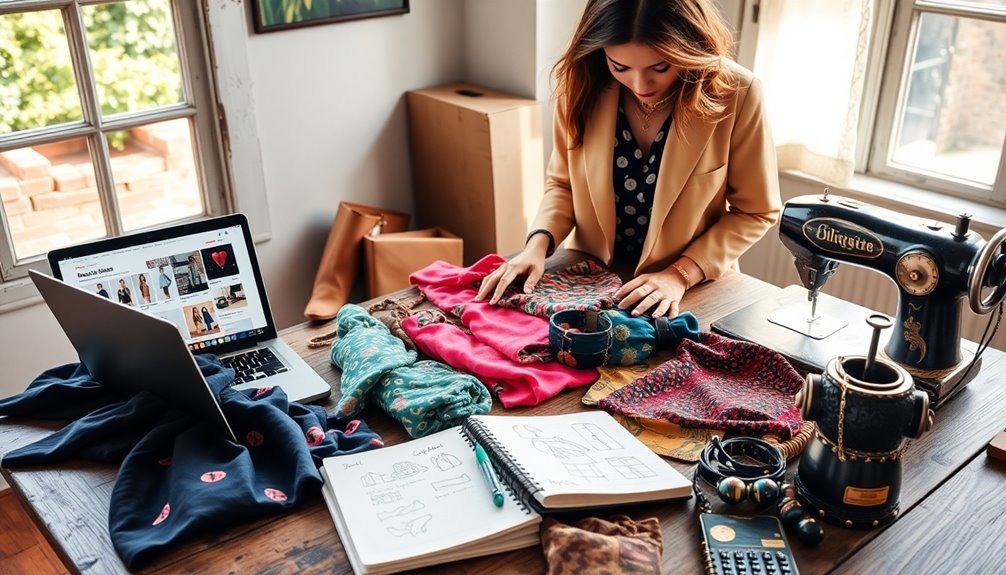
If you're looking to dive into the fashion world, there are plenty of popular side hustles that can turn your creativity into cash. One option is to become a fashion illustrator, where you can earn between $30,000 and $80,000 per year by creating fashion concepts through hand drawing or vector graphic software. Platforms like Upwork can help you find clients, so be sure to showcase your portfolio. Additionally, many illustrators benefit from functional cookies to enhance their online presence through targeted advertising.
Another lucrative avenue is custom clothing design. By utilizing your sewing skills, you can charge hundreds to thousands of dollars per piece. Having a strong understanding of fashion illustration can also give you an edge in creating unique designs. Building a diverse portfolio and networking with local boutiques will help you attract clients. If you have a knack for design, consider creating custom fabrics on platforms like Spoonflower. You can also branch into handmade accessories, selling your creations online or at local markets.
For those interested in reselling, platforms like Poshmark and eBay allow you to sell vintage items, potentially marking up prices by 50-100%. Whether you're styling clients or decluttering wardrobes, there's a fashion side hustle that fits your skills and passion.
Tips for Success in Fashion Hustles

Finding success in fashion side hustles requires more than just creativity; it demands a strategic approach. Start by defining your niche and brand. Identify a unique style or specialty, whether it's sustainable fashion or vintage pieces. What sets your brand apart? Focus on a specific niche to attract a targeted audience, and ensure your brand aligns with your values and passions. Many fashion enthusiasts have found that these side hustles allow for creative expression outside traditional 9-5 jobs.
Marketing is crucial. Use social media platforms to showcase your work and connect with potential clients. Consistent posting and engaging content help build a loyal following. Collaborate with influencers or fellow fashion enthusiasts to widen your reach, and network through industry events and online forums.
Time management is key. Create a schedule to balance your day job, personal commitments, and side hustle. Prioritize tasks and set achievable goals to avoid feeling overwhelmed. Delegate when possible to maintain efficiency and ensure quality work.
Lastly, stay informed and adaptable. Keep up with the latest fashion trends and be ready to evolve your business model. Invest in your brand and be open to learning. Maintaining professionalism and reliability is essential for building long-term client relationships.
Frequently Asked Questions
How Do I Find Clients for My Fashion Side Hustle?
To find clients for your fashion side hustle, start by attending networking events and participating in online communities. Consider reaching out to local boutiques or fashion-related businesses to see if they are in need of any freelance work or partnerships. Additionally, look into fall fashion internships to gain valuable experience and build your network in the industry. These opportunities can help boost your portfolio and attract potential clients who are looking for your expertise in the fashion world.
Use social media to promote your services and connect with potential clients.
Don't hesitate to reach out directly via email or LinkedIn.
Join freelance job sites for more opportunities and build a professional network for support and referrals.
Lastly, leverage word-of-mouth by asking friends and family to spread the word about your offerings.
What Are the Common Challenges in Fashion Side Hustles?
In a fashion side hustle, you'll face several challenges. Attracting initial clients can be tough, so networking's essential.
You'll need to stay updated on trends, which requires continuous learning.
Balancing your hustle with a full-time job demands effective time management.
Financially, you might need to invest in quality tools while managing unpredictable income.
Lastly, building a reputation takes time and effort, so be prepared for setbacks and stay resilient.
How Do I Market My Fashion Side Hustle Effectively?
To market your fashion side hustle effectively, leverage social media platforms like Instagram and TikTok.
Create engaging content, such as short videos showcasing your products. Collaborate with influencers who resonate with your brand, and run contests to boost engagement.
Always respond to comments and messages promptly to build a strong community. Use user-generated content to enhance authenticity and consider starting a blog to share insights and trends that connect with your audience.
Can I Combine Multiple Fashion Side Hustles?
Yes, you can combine multiple fashion side hustles!
With strong time management and organization, you'll find it's possible to juggle different roles. Consider freelance jobs that offer flexibility, allowing you to work evenings or weekends.
Balancing various tasks not only keeps you busy but also enhances your understanding of the fashion industry.
Just remember to set clear goals and create a schedule that accommodates all your commitments effectively.
What Platforms Are Best for Selling Fashion Items Online?
When you're looking to sell fashion items online, consider platforms like eBay for versatility, Poshmark for social engagement, and Depop for a trendy audience.
Mercari offers a straightforward selling process, while Facebook Marketplace connects you with local buyers.
If you're focusing on high-end items, check out TheRealReal or Vestiaire Collective.
For kids' clothing, Kidizen is a great option.
Each platform has unique features that can help you maximize your sales.
Conclusion
In conclusion, exploring fashion side hustles can be a rewarding venture if you keep key factors in mind. Prioritize flexibility, assess your skills, and consider initial investments to find the perfect fit for your lifestyle. Stay informed about market trends and your client base to maximize your earnings. With the right approach, you can turn your passion for fashion into a thriving supplementary income. So go ahead, embrace your creativity, and start your journey today!

